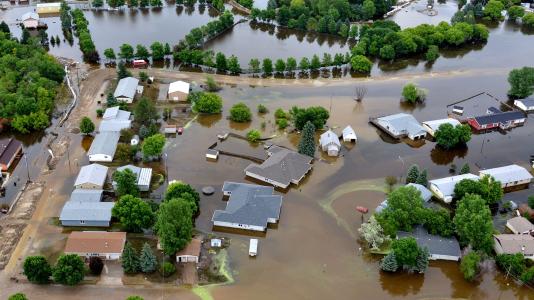
These seven things explain the challenges and payoffs of one of Argonne’s new approaches to disaster resilience.
1. Floods are one of the most common — and destructive — natural hazards in the world
According to the World Economic Forum, one recent study found that in a 20-year period from 1995 to 2015, flooding accounted for 43 percent of all recorded global natural disasters — making it the most common by far. (Storms were second, at 28 percent, and earthquakes third at 8 percent.)
2. But accurately predicting floods, especially in urban areas, is exceedingly difficult
This is because rainfall patterns can vary across small areas and can often escape detection by patchy rain gauge networks. Predictions must also account for unique landscape features that could affect flooding, as well as how fast the rain is falling. (For example, rain that falls in 6 hours could have very different flood effects than the same amount of rain spread out over 24 hours.)
3. A new tool developed at Argonne can predict floods more accurately than ever before
It offers a new way to analyze weather data, taking advantage of the laboratory’s unique, high-performance computing resources and overcoming important limitations of previous approaches. It is the most comprehensive flood-predicting tool for urban areas to date.
4. It’s the equivalent of deploying millions of rain gauges throughout an area
The tool takes data from Doppler radar sites and analyzes it with a powerful collection of mathematical equations. Then it combines the data with a detailed model that incorporates geographic features and urban buildings.
5. Using their new model, researchers can now predict flooding within feet, not miles
That’s important, because storms that produce the highest rainfalls tend to be in small areas; the intensity of the rain can vary considerably between areas less than 100 feet apart. Studying past storms shows that predicted flood depths from a single rain gauge can be off by up to a foot and a half compared to radar-based rainfall data.
6. Argonne scientists are acting locally, and thinking globally
Argonne initially developed and deployed this tool as part of a Department of Homeland Security resilience program in Portland, Maine. Despite the regional focus at the beginning, the collaborative work and the information it yielded could reach far beyond Maine, with resulting benefits for science and society.
7. Accurately predicting floods would reduce their human and economic toll
By understanding how extreme storms will affect areas, city planners, local communities, and business coalitions can make better decisions about how to improve storm drainage and flood preparedness. Other benefits could include using land more strategically and decreasing damage with various flood-reducing methods — potentially saving countless lives, homes, and businesses.
Argonne National Laboratory seeks solutions to pressing national problems in science and technology. The nation’s first national laboratory, Argonne conducts leading-edge basic and applied scientific research in virtually every scientific discipline. Argonne researchers work closely with researchers from hundreds of companies, universities, and federal, state and municipal agencies to help them solve their specific problems, advance America’s scientific leadership and prepare the nation for a better future. With employees from more than 60 nations, Argonne is managed by UChicago Argonne, LLC for the U.S. Department of Energy’s Office of Science.
The U.S. Department of Energy’s Office of Science is the single largest supporter of basic research in the physical sciences in the United States and is working to address some of the most pressing challenges of our time. For more information, visit https://energy.gov/science.